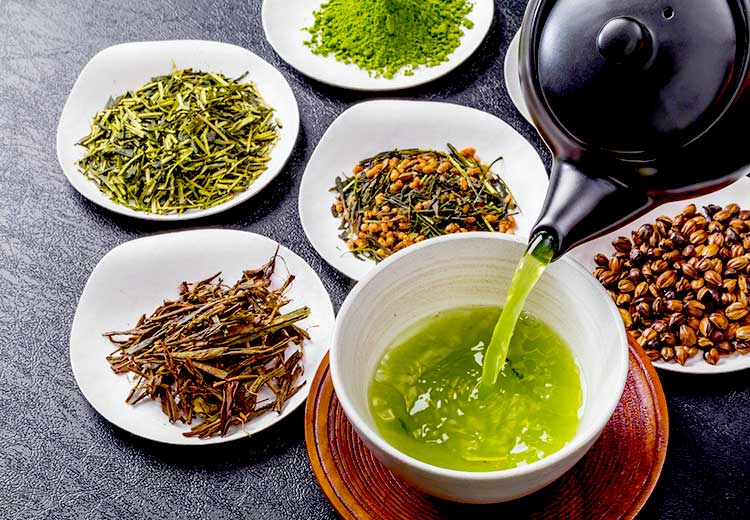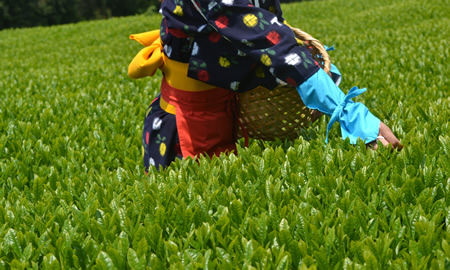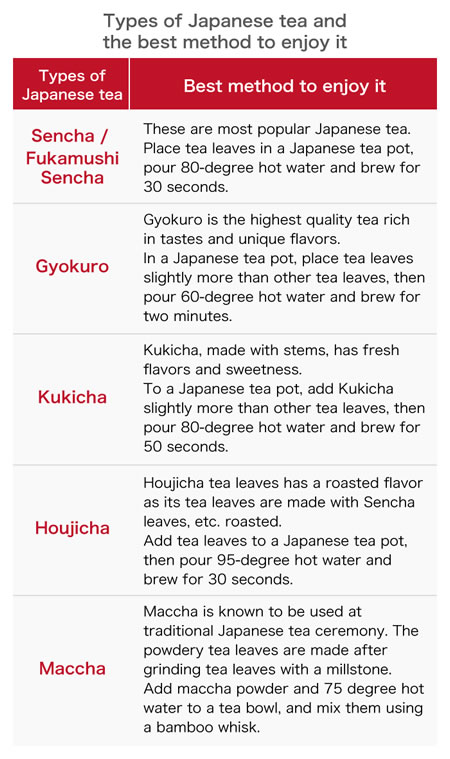Essiential Ingredients of Japanese Food - Japanese tea

Japanese tea
A healthy yet delicious tea that is easy to serve
Rich in the blessing of the nature that contains various nutrition

Since an olden time, when the effect of Japanese tea had not yet proved scientifically, people were drinking tea to keep sickness away. People in these times have known the greatness of tea physically.
Japanese tea contains catechin, a substance that helps reducing blood cholesterol and prevents fat from being absorbed. Catechin is a factor of the unique bitterness of Japanese tea. Also, Japanese tea is rich in vitamin c, and it can be effectively consumed without being damaged by heat when taking it with catechin. Other substances like caffeine and theanine provide relaxation effects.
Seasons for tea

Just like First Flush and Second Flush for English tea, Japanese tea has a certain period to pluck new leaves. The first tea (ichiban-cha in Japanese) is made with leaves newly grow in that season, then the second tea (niban-cha) is made with leaves after the first tea leaves, then followed by the third tea, and so on. The leaves for the first tea are harvested between the mid-April and the mid-May, and those for the second tea are plucked between the end of June to the early July. The third tea between the mid July – the early August.
Since an ancient time, Japanese tea leaves are harvested around a day called “Hachijuhachiya” (literally means ‘the eighty‐eighth day from the beginning of spring’), a unique Japanese calendar seen when seasons change from spring to summer (early May). Even now, before/after the day is the busiest for tea plucking.
Types of Japanese tea and how to enjoy it

Japanese tea, English tea and Oolong tea are made with the same tea leaves, but they are processed in different methods. The principle rule of making Japanese tea leaves is “steam, rub and dry it”, which is much simpler than those for English tea and Oolong tea. Japanese tea has a variety of types depending of a harvesting period for tea leaves and different process methods.
Maccha sweets are accepted by sweets lovers all over the world.

Maccha flavored sweets have been drawing attentions globally including the south-eastern countries like Taiwan and Thailand. Maccha is served in a traditional Japanese tea ceremony. Its slight bitterness are the factor of the popularity with no boundaries as the flavor is not too sweet and has freshness. Maccha is also stimulating the creativity of patissiers in the world because the flavor can be used for any sweets including ice creams, cakes and pudding, and its powdered state is easy to use as an ingredient for sweets.
It is also a great advantage that we can expect a healthy effect as it is rich in catechin.
